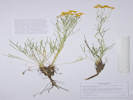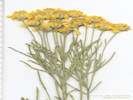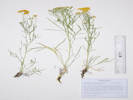|
Literature Cited:
- Anonymous, 1904.
|
|
Salida Record, August 26, 1904:
B. F. Spencer, representing the Continental Crude Rubber Company,
came in from Denver and imparted the information that the machinery for establishing the Salida plant
for extraction of crude rubber from the rubber plant, had been shipped from Denver previous to his departure.
Owing to the slow progresss of freight trains it had not reached here this morning but is expected on every train.
The old creamery building will be utilized to accommodate the plant and it is expected by the time
the rubber plant is ripe for treatment, which is after the first frost, the machinery will all be placed
and everything in readiness for making rubber.
The importance of this announcement will be realized when it is stated that this will be the first plant
of machinery established in the world for the purpose of extracting crude rubber from the native plant,
and the first crude rubber extraction plant of any sort whatever ln the United States.
The success of the enterprise means the inauguration of a vast industry for arid America.
|
|
Literature Cited:
- Anonymous, 1906.
|
|
?IX.—COLORADO RUBBER.
(Hymenoxys
[K.B., 1906, pp. 218-219.]
Early in 1904 a correspondent forwarded to Kew an extract from the Denver Post of 26th November, 1903,
which gave a somewhat enthusiastic account of the discovery by a prospector in Colorado of a rubber-yielding plant.
This was spoken of as occurring abundantly in the hills and mesas in the vicinity of Salida, the belt extending into the San Luis Valley,
Gunniston County, and as far south as New Mexico.
In June, 1905, Mr. E. Naylor, of Bradford, presented to the Museum at Kew a specimen of the dried plant, together with samples of crude and manufactured rubber obtained from it.
Mr. Naylor subsequently also communicated seeds of the plant.
Mr. T. D. A. Cockerell, to whom the Museum is also indebted for specimens of the plant and of its rubber,
published an account of the species in the Bulletin of the Colorado Museum for December, 1903.
The plant, which is a member of the natural family Compositae,
is there identified as Picradenia floribunda, utilis,
which Mr. Cockerell considers to be part of the aggregate Actinella Richardsoni.
Subsequently, in the Bulletin of the Torrey Botanical Club -for 1904, p. 461,
the same author has indicated that Picradenia may be considered a subgenus of Hymenoxys, Cass.
If this view be correct the Colorado Rubber plant is therefore a species of Hymenoxys.
In July, 1906, Mr. Naylor forwarded to Kew a further supply of material.
Accompanying this was the following extract from the letter which Mr. Naylor had received
with the specimens: — " I have obtained a sample of crude rubber from the experimental plant at Buena Vista;
this is, of course, not vulcanised, and if kept in a warm place will become soft and sticky.
The round piece is just as it comes from the plant;
the flat piece is after its second trip through the machine, and in this form is shipped east to the refinery.
The full size of the pieces as shipped is 10 to 15 feet long and 18 inches wide.
The root of the native plant yields about 10 per cent, of rubber."
From the evidence thus obtained there is hardly room for doubt that this species of Hymenoxys yields a rubber-like product.
This does not, however, compare favourably with many of the lower grades of rubber already on the market.
It is therefore somewhat doubtful whether the expectations which have been formed regarding it
in some quarters will be realised.
|
| |
Literature Cited:
- Anonymous, 1906.
|
|
Wild Rubber
This industry is only just starting.
The plant was only discovered a couple of years since, by accident, since which time experiments have been made by individuals,
companies and rubber manufactories, and it has been proven beyond a doubt that a new region and a new source of pure rubber has been found.
The plant grows wild over a vast territory in the mountains, but can and will be cultivated, the same as any farm crop.
It reproduces itself from roots remaining in the ground, and from seed.
Thousands of acres of government land around Salida suitable for its growth can be homesteaded.
An extraction mill is now being installed by the Rocky Mountain Crude Rubber and Development company,
which has made several trial runs and proven to be a success.
The plant produces from ten to fifteen per cent of raw rubber to the ton.
Crude rubber is now worth $1.40 per pound.
It is estimated under cultivation an acre will will yield 3 tons of plant.
It is now selling at $40 per ton.
Salida is the center of the rubber territory and the outlook is that this industry will increase the population,
not only of the city but the entire country.
|
| |
Other articles:
• Forest Road 311:
collecting locality;
• Field Notes:
Coll. No. 2189, 5 Aug 2019;
 Coll. No. 2189, Hymenoxys richardsonii var. floridunda Coll. No. 2189, Hymenoxys richardsonii var. floridunda
 Distal leaves and inflorescence of Coll. No. 2189, Hymenoxys richardsonii var. floridunda Distal leaves and inflorescence of Coll. No. 2189, Hymenoxys richardsonii var. floridunda
|
Field identification: Packera?
|
Plants of Colorado
Asteraceae
Hymenoxys richardsonii (Hook.) Cockerell var. floribunda (A. Gray) Parker.
Colorado Rubberweed.
Trout Creek Pass, Chaffee County, Colorado.
Along Chaffee County Road 311, about 0.8 mi. west of its intersection with US Highway 285 at Trout Creek Pass, 149 km. southwest of the GNIS location of Golden.
38.9082°N, 105.9888°W.
WGS 1984
Elev. 2883 m.
Collected by permit: Pike-Isabel National Forest, 2019, issued: Mar 8, 2019, to: Tom Schweich.
|
Tom Schweich
2189. |
5-Aug-2019 |
|
Coll. No. 2189, 5 August 2019, characters observed:
Perennial, sub-shrub, 20 cm.,
caudex, branched, woody;
Stem,
clusters of tomentum,
glandular;
Leaves,
basal and cauline,
25-60 mm. × 15-15 mm. wide,
reduced distally,
pinnately lobed into 3 linear segments,
0.8-1.8 mm. wide,
glandular punctate,
little bits of tomentum here and there,
margins,
entire;
Inflorescence,
head enclosed by an involucre,
1 per stem,
showy,
flat-topped,
not overtopped by leaves;
Peduncles,
40 mm.,
inconspicuously glandular;
Involucre,
5 mm. × 10 mm. wide,
hemispheric,
glandular,
scattered tomentose;
Phyllaries,
2 series,
series 1, 4.5 mm. × 2 mm. wide, fused ½, lanceolate,
series 2, 4 mm. × 1.5 mm. wide, widest above middle;
Receptacle,
conic,
epaleate;
Flowers,
2 kinds;
Ray flowers,
#8-10,
tube 1.9 mm. + blade 5.5 mm. × 4.8 mm. wide,
obovate,
yellow,
fertile;
Disk flowers,
many,
tube 3.5 mm. + lobes 0.4 mm.,
throat expanding,
yellow;
Pappus,
few,
well-developed scales,
1.8 mm.,
±equal;
Fruit (cypsela),
2.5 mm.,
hairy.
| |
Other articles:
• Forest Road 435:
61000;
• Field Notes:
Coll. No. 2564, 12 Jul 2021;
 Coll. No. 2564, Hymenoxys richardsonii var. floribunda Coll. No. 2564, Hymenoxys richardsonii var. floribunda
|
Hymenoxys richardsonii var. floribunda.
|
Plants of Colorado
Asteraceae
Hymenoxys richardsonii (Hook.) Cockerell var. floribunda (A. Gray) Parker.
Colorado Rubberweed.
Salt Creek, Park County, Colorado.
South-facing hillside along Salt Creek and Pike-San Isabel National Forest Road 435 "Salt Creek Road," 3.2 mi. by road west of US Highway 285, 145 km. southwest of the GNIS location of Golden.
38.9583°N, 106.0126°W.
WGS 1984
Elev. 2871 m.
Open hillside with pines, also collected here: Oreocarya thyrsiflora, Penstemon barbatus, Chaenactis douglasii, Gutierrezia sarothrae, and Muhlenbergia montana.
Collected by permit: Pike - San Isabel National Forest, 2021, issued: Mar 29, 2021, to: Tom Schweich.
|
Tom Schweich
2564. |
12-Jul-2021 |
|
| |
|
Literature Cited
A list of all literature cited by this web site can be found in the Bibliography.
| | |
Anonymous. 1903.
Rubber.
The Commercial Stamp Trade Journal.
12(5):5.
|
| |
Anonymous. 1904.
History of Business in Chaffee County.
Salida Colorado History.
Link to external document.
Date retrieved: 15 January 2018, URL:
|
| |
Anonymous. 1906.
IX.-Colorado Rubber.
Bulletin of Miscellaneous Information.
Additional Series, VII. Selected Papers from the Kew Bulletin.
|
| |
Anonymous. 1908.
Sunny Salida Colorado.
Salida, Colorado: The Salida Board of Trade, 1908.
{TAS-pdf}
|
|
If you have a question or a comment you may write to me at:
tomas@schweich.com
I sometimes post interesting questions in my FAQ, but I never disclose your full name or address.
|
[Home Page] [Site Map]
Date and time this article was prepared:
5/12/2025 2:41:11 PM
|
|
 Eastern Mojave Vegetation
Eastern Mojave Vegetation
 Eastern Mojave Vegetation
Eastern Mojave Vegetation
